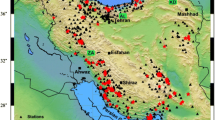Abstract
Earthquake ground motion is a spatial phenomenon associated with local random behavior and global attenuation away from a source. By this description, ground motion is a regionalized variable. Analyses of directional variograms for earthquake ground motion reveal ansiotropic attenuation. For some earthquakes, a spatial structure exists in all directions and an average variogram can be developed. For other earthquakes, either a spatial structure can be identified only for restricted directions, or a spatial structure cannot be found to exist in any direction. A valid application of regionalized variables theory to the spatial analysis of earthquake ground motion must therefore be predicated on an initial, exhaustive analysis of estimated variograms. To estimate these data, an application of ordinary kriging is preferable to other more complex regionalized variables techniques to simplify the spatial analysis of earthquake ground motion.
Similar content being viewed by others
References
Armstrong, M. and Jabin, R., 1981, Variogram models must be positive definite: Int. Jour. Math. Geol., v. 13, no. 5, p. 455–459.
Armstrong, M., 1984, Problems with universal kriging: Int. Jour. Math. Geol., v. 16, no. 1, p. 101–108.
Brooker, P. I., 1982, Semi-variogram estimation using a simulated deposit, SME preprint 82-11: SME-AIME Annual Meeting, Dallas, Texas, February 14, 1982.
Carr, J. R., 1983, Application of the theory of regionalized variables to earthquake parametric estimation and simulation: Ph.D. dissertation, University of Arizona, 259 pages.
Carr, J. R. and C. E. Glass, 1984, Estimation of earthquake response spectra using krigingin Proceedings of the 2nd NATO Advanced Study Institute of Geostatistics for Natural Resources Characterization: D. Reidel Publishing Co., Dordrecht, Holland.
David, M., 1977, Geostatistical ore reserve estimation: Elsevier, Amsterdam, 364 p.
Delfiner, P., 1976, Linear estimation of non-stationary spatial phenomena,in M. Guarascio, et al. (Eds.), Advanced Geostatistics in the Mining Industry: D. Reidel Publishing Co., Dordrecht, Holland.
Dunn, M. R., 1983, A simple sufficient condition for a variogram model to yield positive variances under restrictions: Int. Jour. Math. Geol., v. 15, no. 4, p. 553–564.
Glass, C. E., 1978, Application of regionalized variables to microzonation,in Proceedings of the Second International Conference on Microzonation for Safer Construction: Res. Appl., vol. 1, p. 509–521.
Goodman, A., 1983, COMPARE: A Fortran IV program for the quantitative comparison of polynomial trend surfaces: Comput. Geosci., v. 9, no. 3, p. 417–454.
Journel, A. G. and Ch. J. Huijbregts, 1978, Mining geostatistics: Academic Press, New York, 600 pp.
Luckacs, E., 1970, Characteristic functions, 2nd ed.: Charles Griffin and Co., Ltd., London.
Mandrescu, N., 1978, The Vrancea earthquake of March 4, 1977 and the seismic microzonation of Bucharest,in Proceedings of the Second International Conference on Microzonation for Safer Construction: Res. Appl., v. 1, p. 399.
Matheron, G., 1972, Les covariances geostatistique, polynomiales, N-299: Centre de Geostatistique, Fountainbleau, France.
“United States Earthquakes,” published anually by the U.S. Department of Commerce, Coast and Geodetic Survey from 1928–1968, the NOAA National Ocean Survey in 1969, the NOAA Environmental Data Service from 1970–1972, and jointly by the NOAA Environment Data and Information Service and the U.S. Geological Survey thereafter.
Author information
Authors and Affiliations
Rights and permissions
About this article
Cite this article
Carr, J.R., Glass, C.E. Treatment of earthquake ground motion using regionalized variables. Mathematical Geology 17, 221–241 (1985). https://doi.org/10.1007/BF01034751
Received:
Revised:
Issue Date:
DOI: https://doi.org/10.1007/BF01034751




